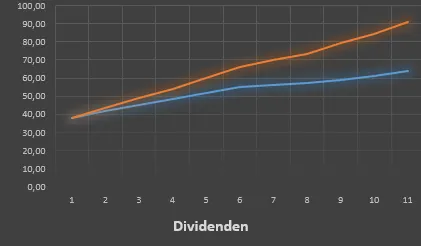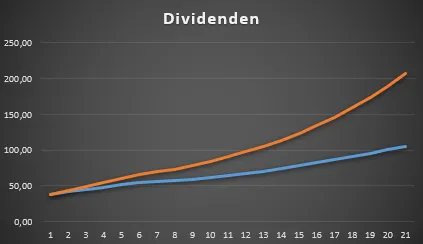English
When I started investing in stocks from zero about 7 years ago, I could not have imagined that after a relatively short period of time, the effect of compounding would already be noticeable.
What Is the Meaning of Compound Dividend?
Among equity investors, compounding dividends describes the capital gain or dividend that investors earn on distributions already received and reinvested. Capital grows faster the sooner the profit is reinvested. Time plays a central role because the effect increases exponentially on the assets. Albert Einstein called this effect the "8th wonder of the world". That's also where the phrase "make the money work for you" comes from.
Example based on the Procter & Gamble share (shown simplified without taxes and costs)
The company Procter and Gamble enjoys great popularity especially among dividend investors and is known for its famous brands Gillette, Pampers, Head & Shoulders, Oral-B or Pantene Pro-V. The company has increased its dividend every year since 1956.
Example 1
Purchase over 21 shares worth €1,000 of Procter and Gamble 10 years ago without reinvestment of dividends received.
Result: Share value (21 shares at €114 each) of €2,394 and dividends received of €578.
Total: 2,972 €
Example 2
Purchase over 21 shares worth €1,000 from Procter and Gamble 10 years ago including annual reinvestment of dividends received.
Result: Share value (30 shares of €114 each) of €3,420 and dividends received of €708.
Total: € 4,128 €

Based on the annual dividends, one can see the widening gap over the years (blue and orange line) and the acceleration of the compound dividend effect.
Remarkable, that I only compared a 10-year cycle in which Procter and Gamble's average dividend increase was a comparatively small 5.24% per year. There are companies that show an increase rate of more than 10% per annum, even over a longer period of time.
If I assume further increases of 5.24% over the next 10 years, the consequence becomes even clearer.

However, the increase in value of the shares, with a difference of over €1,000 over 10 years, and, calculated purely prophylactically without further price increases, €2,300 over 20 years, is extraordinary and illustrates the importance of reinvestment.
My own experience
Over the coming decades, I will try to build up a retirement provision as comfortable as possible.
In investor-friendly countries such as the USA, almost all well-known stock corporations and brokers offer the possibility of reinvesting the dividends paid out directly in the shares by means of a "DRIP" (Dividend ReInvesting Plan) without any expense or taxation.
In Germany, this procedure is unfortunately not yet possible, with a few exceptions. Therefore, I reinvest the received and taxed dividends in shares via a savings plan. Of course, it does not necessarily have to be the same company, but is subject to my own selection.
It doesn't always have to be dividends
Personally, I prefer steady cash flow and dividend stocks play a fundamental role in my investment strategy. After 7 years on the stock market, I already receive up to €300 in dividends per month.
Of course, there is the alternative to buy growth stocks in order to profit exclusively from the strongly rising share price. These companies reinvest their earnings completely in their own business, thus ensuring even more growth. Accordingly, the profits are compounded and the shareprice follows the profit of the company, which is exponential in the best case.
I own some of these stocks myself. Amazon and Alphabet are currently the most notable examples.
Conclusion
Only the compound dividend effect makes investing money on the stock market really fun. Small investors should by no means underestimate the power of the "8th wonder of the world". The younger the investor, the more noticeable the power of compounding dividends.
Deutsch
Als ich vor ungefähr 7 Jahren bei "Null" mit dem Investieren in Aktien begann, hätte ich mir nicht vorstellen können, dass bereits nach relativ kurzer Dauer der Effekt des Zineszins spürbar ist.
Was ist der Zinseszins ?
Unter Aktieninvestoren beschreibt der Zinseszins den Kursgewinn oder die Dividende, welche Anleger auf bereits erhaltene und reinvestierte Ausschüttungen erlangen. Das Kapital wächst umso schneller, desto eher der Gewinn wieder eingesetzt wird. Die Zeit spielt eine zentrale Rolle, weil die Wirkung exponentiell auf das Vermögen zunimmt. Albert Einstein bezeichnete diesen Effekt als das "8. Weltwunder". Daher stammt auch der Satz "das Geld für dich arbeiten lassen".
Beispiel anhand der Aktie von Procter & Gamble (vereinfacht ohne Steuern und Kosten dargestellt)
Das Unternehmen Procter and Gamble erfreut sich speziell unter Dividendeninvestoren großer Beliebtheit und ist für seine berühmten Marken Gillette, Pampers, Head & Shoulders, Oral-B oder Pantene Pro-V bekannt. Seit 1956 steigert der Wert jährlich seine Dividende.
Beispiel 1:
Kauf über 21 Aktien im Wert von 1.000 € von Procter and Gamble vor 10 Jahren ohne Reinvestition der erhaltenen Ausschüttungen.
Ergebnis: Aktienwert (21 Stück à 114€) von 2.394 € und 578 € erhaltene Dividenden.
Gesamt: 2.972 €
Beispiel 2:
Kauf über 21 Aktien im Wert von 1.000 € von Procter and Gamble vor 10 Jahren inkl. jährlicher Reinvestition der erhaltenen Ausschüttungen.
Ergebnis: Aktienwert (30 Stück à 114 €) von 3.420 € und 708 € erhaltene Dividenden.
Gesamt: 4.128 € €

Anhand der jährlichen Dividenden erkennt man die mit den Jahren immer breiter werdende Kluft (blaue und orangene Linie) und die Beschleunigung des Zinseszinseffekt.
Wohlgemerkt habe ich nur einen Zyklus von 10 Jahren verglichen, in dem die durchschnittliche Dividendenerhöhung von Procter and Gamble mit 5,24 % pro Jahr vergleichsweise gering ausfiel. Es gibt Firmen, die eine Steigerungsrate von über 10 % per Annum, auch über einen längeren Zeitraum aufweisen.
Setze ich für die kommenden 10 Jahre weitere Anhebungen von 5,24 % voraus, sieht man die Konsequenz noch klarer.

Doch auch der Wertzuwachs der gehaltenen Papiere mit einer Differenz von über 1.000 € über 10 Jahre, und, rein prophylaktisch ohne weitere Kurssteigerung gerechnet, 2.300 € über 20 Jahre ist mehr als beachtlich und verdeutlicht die Wichtigkeit der Wiederanlage.
Zinseszins in der Praxis - eigene Erfahrung
Über die kommenden Jahrzehnte versuche ich mir in der Form eine möglichst komfortable Altersvorsorge aufzubauen.
In den anlegerfreundlichen Staaten wie den USA bieten nahezu alle bekannten Aktiengesellschaften und Broker die Möglichkeit per "DRIP" (Dividend ReInvesting Plan) die ausgezahlten Tantieme ohne Aufwand und ohne Versteuerung direkt in die Aktie wiederanzulegen.
In Deutschland ist dieses Verfahren leider, bis auf wenige Ausnahmen, noch nicht möglich. Daher lege ich die empfangenen und versteuerten Gewinnanteile per Sparplan wieder in Aktien an. Dabei muss es sich natürlich nicht zwangsläufig um das gleiche Unternehmen handeln, sondern unterliegt meiner eigenen Auswahl.
Es müssen nicht immer Dividenden sein
Ich persönlich bevorzuge den steten Cashflow und Dividendentitel spielen bei meiner Anlagestrategie eine elementare Rolle. Nach 7 Jahren an der Börse erhalte ich schon bis zu 300 € Dividenden je Monat.
Selbstverständlich gibt es die Alternative Wachstumswerte zu kaufen um ausschließlich vom stark steigenden Kursverlauf zu profitieren. Diese Unternehmen reinvestieren ihre Erträge komplett in das eigene Geschäft und sorgen damit für noch mehr Wachstum. Die Gewinne werden demnach aufgezinst und der Kurs folgt dem im besten Fall exponentiellen Gewinn.
Ich selber besitze einige dieser Aktien. Amazon und Alphabet sind aktuell die namhaftesten Beispiele.
Fazit
Erst durch den Zinseszinseffekt macht die Geldanlage an der Börse so richtig Spaß. Kleinanleger sollten die Macht des "8. Weltwunders" keinesfalls unterschätzen. Umso jünger der Anleger, desto stärker macht sich die Kraft des Zinseszins bemerkbar.